I’ll be honest—when I first started looking for a way to spruce up my dingy basement floor, I was overwhelmed by the options. But after weeks of research and a hands-on test, I’m convinced DRYLOK Concrete Floor Paint is the real deal.
It’s not just about giving your concrete a fresh look; it’s about durability, ease, and protection that lasts. Whether you’re tackling a garage, patio, or basement, this paint delivers a finish that’s tough, non-slip, and easy to maintain.
Trust me, you’ll want to grab a can and transform your space.
My Journey With DRYLOK Concrete Floor Paint
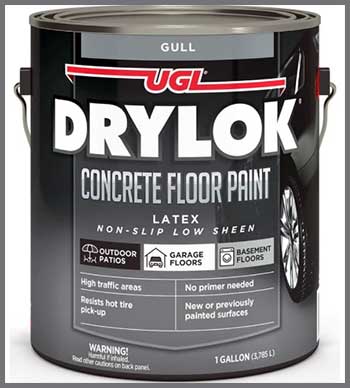
Picture this: my basement floor was an eyesore—gray, stained, and screaming for a makeover.
I wanted something that would not only look good but also stand up to the daily grind of foot traffic, spills, and the occasional dampness that comes with living in a rainy area.
After scouring forums and product reviews, I landed on DRYLOK Concrete Floor Paint.
I chose the Dover Gray shade, hoping it would brighten up the space without being too stark.
Spoiler alert: it did not disappoint.
The first thing that struck me was how straightforward the prep work was. I’m no DIY guru, but the instructions were clear. I scrubbed the floor with a heavy-duty detergent to get rid of years of grime, then used DRYLOK Etch to tackle some stubborn efflorescence—those white, powdery deposits that scream “moisture problem.”
After rinsing and letting the floor dry, I did the plastic sheet test to check for trapped moisture. It was bone dry, so I was ready to paint. The first coat went on with a brush, as recommended, and I thinned it slightly with water to ensure it soaked into the concrete.
Four hours later, I rolled on the second coat, and the transformation was already jaw-dropping.
Applying DRYLOK felt like a breeze compared to other paints I’ve used. Its creamy consistency didn’t drip or splatter, and cleanup was as simple as soap and water. Within a day, my basement floor went from drab to fab, with a smooth, non-slip finish that made the space feel like an extension of my home.
I’ve been walking on it for months now, and it’s held up to everything—spilled coffee, heavy boxes, even my dog’s muddy paws. It’s not just paint; it’s like armor for your floor.
What Makes DRYLOK Stand Out?
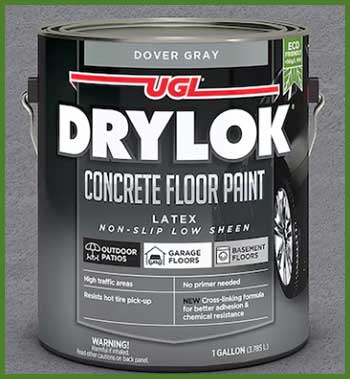
Let’s talk about why DRYLOK Concrete Floor Paint is a cut above the rest.
This isn’t your average can of paint—it’s an all-in-one paint and primer designed specifically for masonry surfaces.
The formula is packed with advanced technology, like ceramic fortification and a low-VOC composition, which means it’s tough, environmentally friendly, and safe for indoor use.
I was impressed by how it’s formulated to match the pH of concrete, ensuring it bonds tightly and doesn’t peel like traditional paints. Plus, it’s GreenWise Certified, so you’re not breathing in nasty fumes while you work.
The non-slip finish is a game-changer. My basement gets a lot of foot traffic, and I was worried about slick surfaces, especially when wet. DRYLOK’s flat finish provides just the right amount of grip without feeling like sandpaper underfoot.
It’s also resistant to hot tire pickup, which is a big deal if you’re painting a garage floor. I tested this by parking my car on a small painted patch after five days of curing, and there wasn’t a single mark. The paint also shrugs off grease, oil, and road salt, making it a low-maintenance choice for busy spaces.
Another thing I love is the color options. With nine ready-mixed shades and a tintable base, you can customize the look to fit your vibe. I went with Dover Gray for a clean, modern feel, but shades like Terracotta or Bamboo Beige could add warmth to a patio or laundry room.
The coverage is solid too—each gallon covers 400-500 square feet, depending on the surface. My 800-square-foot basement took just two gallons, and I had some left over for touch-ups. For a DIY project, DRYLOK makes you feel like a pro without breaking the bank.
The Downsides of DRYLOK
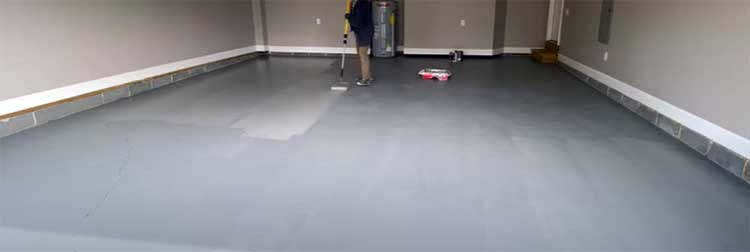
- Prep Work Can Be a Hassle
No paint is perfect, and DRYLOK has its quirks. The prep process, while straightforward, can be time-consuming if your floor is in rough shape. My basement had some efflorescence, which meant I had to spend an afternoon scrubbing and etching.
If you skip this step or rush it, the paint won’t adhere properly, and you’ll be cursing when it starts peeling. The instructions emphasize getting the concrete to feel like medium-grit sandpaper, and they’re not kidding—smooth surfaces need extra elbow grease or acid etching to ensure the paint sticks.
- Not a True Waterproofing Solution
Here’s where I need to set expectations: DRYLOK Concrete Floor Paint isn’t a full-on waterproofing solution. I learned this the hard way when a heavy rain caused a slight seep in one corner of my basement.
While the paint held up and didn’t peel, it didn’t stop the moisture from coming through. If you’ve got serious water issues, you’ll need to address them externally—think proper grading or drainage systems—before painting. DRYLOK is great for mild dampness, but it’s not a miracle worker for leaky basements.
- Limited Finish Options
Another drawback is the lack of finish variety. DRYLOK only comes in a flat, non-slip finish, which is great for safety but might not suit everyone’s aesthetic. If you’re dreaming of a glossy, showroom-like floor, you’ll need to look elsewhere or topcoat with a clear sealer.
I didn’t mind the flat look, but I can see how someone might want a shinier finish for a garage or patio. Just know that adding a sealer means extra cost and effort.
- Curing Time for Heavy Use
Finally, the curing time can test your patience. While the paint is dry to the touch in a couple of hours and ready for light foot traffic in four, you’ll need to wait a full five days before driving a car on it or dragging heavy furniture across.
I made the mistake of moving a storage rack too early, and it left a faint scuff. Lesson learned: give it the full curing time to avoid headaches.
Keeping Your DRYLOK Floor Looking Fresh
- Regular Cleaning Is Key
Maintaining your DRYLOK-painted floor is a breeze if you stay on top of it. I sweep my basement floor weekly to keep dust and dirt from building up. For deeper cleaning, I use a mild detergent mixed with warm water and a soft-bristled mop.
The paint’s resistance to grease and oil means spills wipe up easily—coffee stains and muddy paw prints came off with minimal scrubbing. Just avoid harsh chemicals like bleach, which can dull the finish over time. A quick mop every month keeps my floor looking as good as the day I painted it.
- Watch for Moisture Issues
Since DRYLOK isn’t a waterproofing cure-all, keep an eye out for moisture. I check my basement after heavy rains, especially in corners where water might seep. If you notice damp spots, address them ASAP with a dehumidifier or by improving external drainage.
I added a small dehumidifier to my basement, and it’s made a huge difference in keeping the space dry and the paint intact. If you spot efflorescence creeping through, you’ll need to scrape it off, re-etch, and touch up the paint to prevent peeling.
- Touch-Up as Needed
Minor scuffs or scratches might pop up over time, especially in high-traffic areas. I keep a small can of DRYLOK on hand for touch-ups. Just clean the spot, sand it lightly, and apply a thin coat with a brush.
I had to touch up a corner where my dog’s crate scraped the floor, and it blended seamlessly. Make sure to mix the paint well to match the original color, especially if you’re using a custom tint. Storing leftover paint in a cool, dry place ensures it’s ready when you need it.
- Protect Against Heavy Wear
If you’re using DRYLOK in a garage or patio, protect the surface from heavy wear. I place rubber mats under my car’s tires to prevent hot tire pickup, and I lift heavy items instead of dragging them.
For outdoor surfaces like patios, consider resealing every few years with a clear masonry sealer to boost durability. My neighbor used DRYLOK on<<<<<<< on his patio and added a sealer after two years, and it still looks vibrant. The key is to avoid abrasive cleaners or tools that could damage the paint.
How DRYLOK Stacks Up Against The Competition?
- Behr Premium Concrete Stain
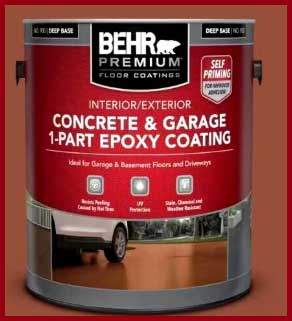
Behr’s Premium Concrete Stain is a popular choice for homeowners looking to refresh outdoor concrete surfaces like patios or driveways.
I tried a small patch of Behr on my patio before settling on DRYLOK for my basement, and the difference was noticeable.
Behr offers a wider range of finishes, including satin, which gives a slightly glossier look than DRYLOK’s flat finish.
It’s also moisture- and mildew-resistant, but it doesn’t have the same non-slip texture as DRYLOK.
I found Behr’s application process similar, but it required more prep work for smooth surfaces, and the coverage was slightly less—about 200-400 square feet per gallon. Behr’s color variety is impressive, with 75 shades, but it felt less durable against oil spills compared to DRYLOK.
For indoor spaces like basements, DRYLOK’s non-slip, low-VOC formula feels better suited, especially for damp environments.
- Rust-Oleum EpoxyShield
Rust-Oleum’s EpoxyShield is a direct competitor to DRYLOK’s E1 Latex 1-Part Epoxy Concrete Floor Paint. I tested EpoxyShield on a garage floor project, and it’s a beast for durability.
Its epoxy formula resists fading, chipping, and stains like a champ, but the curing time is a slog—five days compared to DRYLOK’s three for the epoxy version. EpoxyShield also requires more meticulous prep, including degreasing and sanding glossy surfaces, which felt like overkill for my basement.
DRYLOK’s latex version is easier to apply and clean up, and its non-slip finish is a win for safety. However, EpoxyShield’s glossy finish might appeal to those wanting a polished look, though it’s pricier than DRYLOK’s latex paint.
- Valspar Porch and Floor Paint
Valspar’s Satin Porch and Floor Paint is another option I explored for my patio. It’s designed for high-traffic areas and has a nice anti-slip texture, but I found its application trickier than DRYLOK.
The paint felt thicker, making it harder to spread evenly, and it took longer to dry—about six hours per coat. Valspar’s coverage is decent, around 300-400 square feet per gallon, but it’s not as resistant to heavy chemicals like gasoline or road salt.
DRYLOK’s ability to handle these contaminants without breaking a sweat made it my go-to for the basement, where I needed reliability over aesthetics.
- Sani-Tred Liquid Rubber Membrane
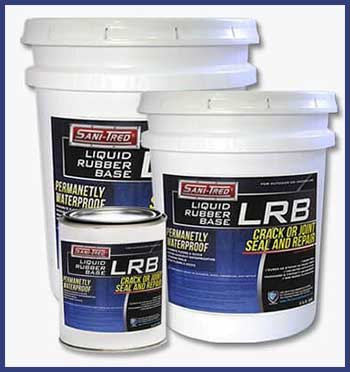
Sani-Tred is a different beast altogether—a liquid rubber membrane marketed as a true waterproofing solution.
I considered it for my basement but stuck with DRYLOK for cost and ease.
Sani-Tred penetrates deeply into concrete, creating a flexible, waterproof barrier that’s ideal for severe water issues.
However, it’s not a paint; it’s a clear coating, so it won’t give you the aesthetic upgrade DRYLOK offers.
Application is more complex, requiring multiple priming coats for porous surfaces, and it’s significantly more expensive—think $100+ per gallon versus DRYLOK’s $25-50.
For decorative purposes and mild moisture protection, DRYLOK is the better pick, but Sani-Tred is the way to go for heavy-duty waterproofing.
Frequently Asked Questions (FAQ)
Absolutely, DRYLOK is a solid choice for concrete floors. I’ve used it in my basement, and it’s held up beautifully against foot traffic, spills, and mild dampness. Its non-slip finish and resistance to grease, oil, and salt make it ideal for garages, basements, and patios. Just don’t expect it to solve major water seepage issues—that requires external fixes. Proper prep, like etching and cleaning, is crucial for long-lasting results, but the effort pays off with a durable, attractive floor.
Durability depends on your needs, but DRYLOK E1 Latex 1-Part Epoxy Concrete Floor Paint is a top contender. Its epoxy-ester resin formula outshines standard latex paints like Behr or Valspar for resisting stains, chemicals, and wear. Rust-Oleum EpoxyShield is equally tough but takes longer to cure. In my experience, DRYLOK’s latex version balances durability and ease of use for most home projects, while the epoxy version steps it up for heavy-duty areas like garages.
Yes, you can walk on DRYLOK paint, and it’s designed for it! The non-slip finish is perfect for foot traffic, and I’ve been tromping around my basement floor with no issues. It’s ready for light walking after four hours, but give it 24 hours for heavier use. For garage floors, wait five days before driving on it to avoid scuffs. I learned this the hard way with a storage rack—patience is key!
DRYLOK dries to the touch in about 30 minutes to an hour, but you’ll need to wait four hours before applying the second coat. I found this timing spot-on during my project, even in a humid basement. Light foot traffic is fine after four hours, heavy traffic after 24, and vehicles need five days. High humidity or low temps can stretch these times, so keep the space well-ventilated.
Wrapping It Up
After painting my basement floor with DRYLOK Concrete Floor Paint, I can’t imagine using anything else. It’s tough, easy to apply, and gives my space a polished, professional look without the hassle.
From its non-slip finish to its resistance to spills and stains, it’s a practical choice that doesn’t skimp on style. Whether you’re revamping a garage, patio, or basement, DRYLOK has you covered with a reliable, long-lasting finish.
Grab a can, follow the prep steps, and watch your concrete floor transform into something you’ll love showing off.
